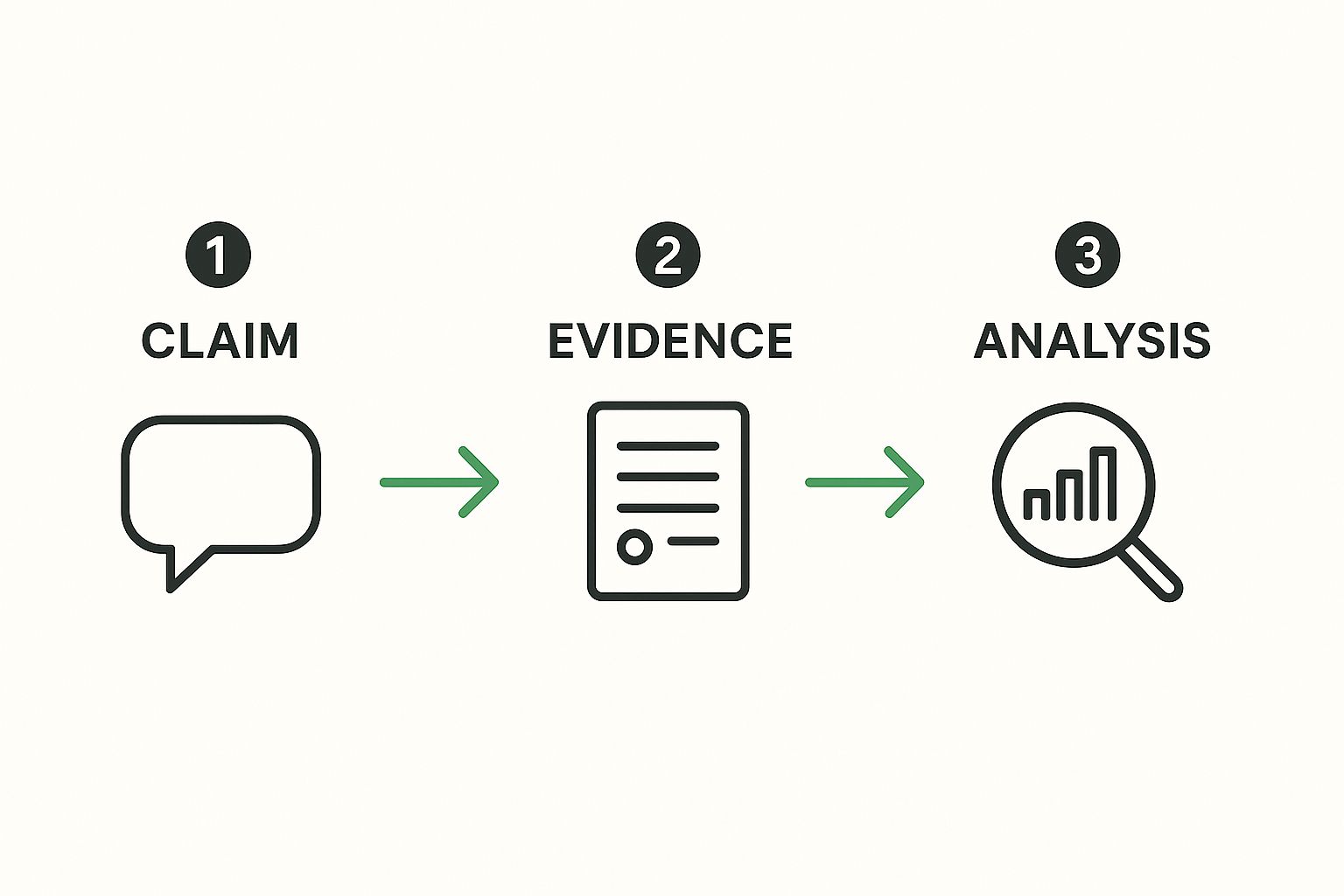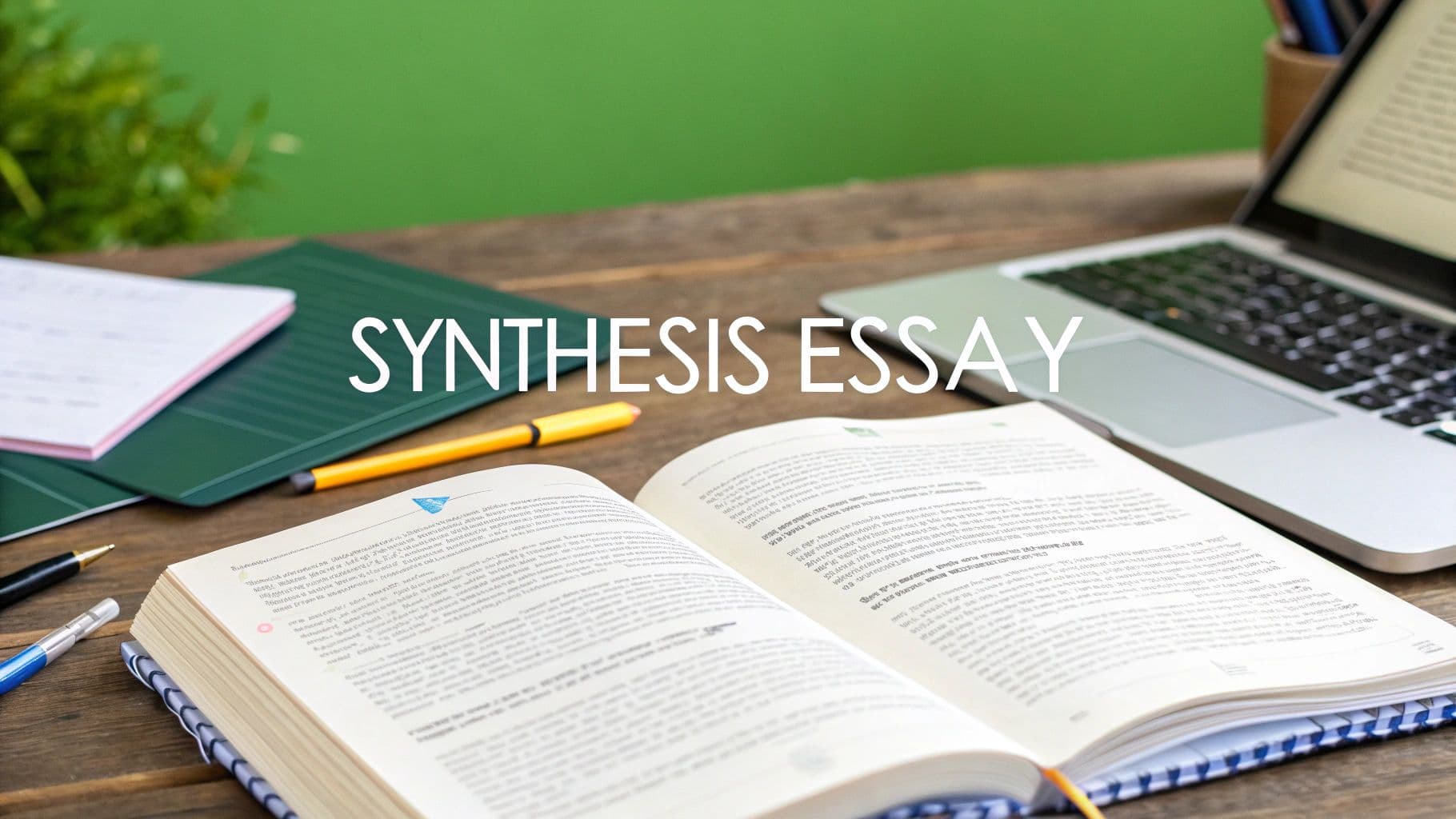
A Practical Guide to Better Academic Writing
July 1, 2025
Let's be real—the phrase "better academic writing" gets thrown around a lot, but what does it actually mean? It's more than just catching typos or getting your grammar right. It’s about building a rock-solid argument, writing with razor-sharp precision, and hitting that perfect objective-yet-confident tone.
It means taking your complex research and transforming it into something structured, persuasive, and, most importantly, respectful of your reader's time.
So, What Does Good Academic Writing Actually Look Like?

We've all been there. You get feedback telling you to "improve your writing," but it feels like a vague, impossible task. Many students and researchers fall into one of two traps: either they try way too hard to sound "academic" by stuffing their sentences with jargon, or they fail to give their ideas a clear, logical flow.
Both paths lead to the same place: confusing, unconvincing work.
But here's the good news. Strong academic writing isn't about using the biggest words in the dictionary. It’s built on a few core pillars that anyone can learn and master. Think of these as your foundation for developing a clear, confident voice that gives your research the attention it deserves.
To get straight to the point, effective academic writing really comes down to a handful of fundamental principles. Focusing your energy here will make a massive difference in the quality of your work.
Here’s a quick breakdown of what to focus on:
| Core Pillars of Effective Academic Writing | | --- | --- | --- | | Pillar | Description | Practical Application | | Clear Argument | Your paper must have a central, debatable thesis. Without it, your work is just a collection of facts, not a focused piece of scholarship. | Formulate a single, clear thesis statement early on and ensure every paragraph supports it. | | Precision | Words must be chosen carefully to convey your exact meaning. Avoid jargon where a simpler term works just as well. | Reread each sentence and ask: "Is there a clearer, more direct way to say this?" Swap vague terms for specific ones. | | Objective Tone | Your writing should be formal, analytical, and free from personal bias or emotional language. The goal is to present findings based on evidence. | Remove personal opinions ("I think," "I believe") and emotive adjectives. Let the data speak for itself. | | Conciseness | Strong academic writing is economical. It gets the point across without unnecessary words, making your argument more powerful. | Hunt down and eliminate filler phrases like "It is important to note that..." and cut repetitive sentences. |
Mastering these pillars is the secret to elevating your writing from just "correct" to truly impactful. You can find more practical tips in our complete academic writing style guide.
The whole point of academic writing isn't to sound smart—it's to communicate complex ideas with absolute clarity. Your job is to guide the reader through your argument so seamlessly that it feels logical and effortless to follow.
And interestingly, this isn't a new problem. As far back as the 1870s, Harvard's president was already complaining about the poor writing skills of incoming students. Today, some educators argue that the rise of social media—where bold, emotional claims often trump well-reasoned arguments—makes it even harder to teach the nuances of rigorous academic writing.
How to Build a Powerful Argument
A strong argument is the absolute engine of any academic paper. It’s what separates a dry collection of facts from a compelling, persuasive piece of scholarship that actually makes a point. And the foundation of every great argument? A sharp, debatable thesis statement. Think of it as the North Star guiding your entire paper. Without one, you're just wandering.
Your thesis isn't a simple statement of fact; it’s a claim you have to prove. For instance, “Climate change is real” is a fact, not a thesis. A real thesis would sound more like this: “Current carbon tax policies are failing to curb climate change because they don't address the consumption patterns of developed nations.” Now that's specific, debatable, and gives your paper a clear direction.
Crafting Your Logical Blueprint
Once you have a killer thesis, you need a blueprint. An outline is your best friend here, forcing you to make sure every single paragraph and piece of evidence directly supports your central claim. Don't just list your topics. Structure your outline to create a logical flow where each point builds on the last, guiding your reader step-by-step toward your conclusion.
Here’s a trick I’ve used for years: write a one-sentence summary for each paragraph you plan to write. This forces you to crystallize its exact purpose. If a sentence doesn't tie back to your thesis, you know that section is either irrelevant or needs a serious rethink.
For a much deeper dive into structuring your paper from the ground up, our guidelines for writing a research paper have some fantastic strategies.
The Claim-Evidence-Analysis Cycle
Every single body paragraph you write needs to follow a simple but powerful cycle: make a claim, provide evidence, and then analyze how that evidence proves your point. This structure is what stops you from just dropping data on the page and instead forces you to interpret it for your reader.
This infographic breaks it down beautifully.

As you can see, the analysis is the critical bridge. It’s what connects the dots between your evidence and your claim, making your argument feel tight and convincing.
Let's look at how this plays out in a history paper:
- Claim: "The invention of the printing press was the single most important factor in fueling the Protestant Reformation."
- Evidence: "Within three months of publication, Martin Luther’s Ninety-five Theses were distributed across Germany, and within two years, throughout Europe."
- Analysis: "This rapid, widespread distribution would have been impossible before the printing press, demonstrating its crucial role in disseminating reformist ideas beyond the academic and clerical elite to the general populace."
Remember, evidence doesn't speak for itself. Your job as a writer is to be the interpreter, explicitly explaining the significance of your findings. This analytical step is what separates a high school report from a university-level paper and is a cornerstone of better academic writing.
Finding Your Authoritative Academic Voice

Crafting the right tone in academic writing can feel like walking a tightrope. You need to sound like a credible expert, but you don't want to come off as stuffy, arrogant, or even robotic. This balancing act is exactly where you discover your academic voice—a tone that feels both authoritative and approachable.
The secret isn't about scrubbing your writing of all personality. It's about grounding your arguments in solid evidence, not emotion. Let your research do the talking. When your claims are backed by strong data and sharp analysis, your confidence shines through naturally, without any need for boastful language.
Adopting a Formal and Precise Tone
A formal tone is a non-negotiable for any kind of better academic writing, but that doesn't mean it has to be stuffy or overly complex. At its core, it just means you need to avoid the casual slang and shortcuts we all use in everyday conversation. This means being deliberate and precise with your word choice.
For instance, instead of saying a result was "really big," you'd specify its impact by describing it as "statistically significant at the p < .05 level." That kind of precision is what gives your statements weight and credibility.
Here are a few common traps to sidestep:
- Colloquialisms: Phrases like "at the end of the day" or "a whole lot" just don't belong in scholarly work.
- Emotional Language: Steer clear of adjectives that communicate personal feelings, like "amazing," "terrible," or "shocking." Stick to neutral, descriptive terms that let the facts speak for themselves.
- Personal Bias: Ditch phrases that signal opinion over fact, such as "I feel that..." or "I believe..." Instead, present your position directly. "The evidence suggests..." is a much stronger and more objective stance.
An authoritative voice isn't about telling the reader what to think. It's about presenting your evidence so clearly and logically that the reader arrives at your conclusion because it's the most sensible one. True authority comes from clarity, not command.
Using Hedging to Project Confidence
This might sound backward, but learning how to hedge your language is one of the most effective ways to project confidence in an academic context. Hedging is just using cautious language to qualify your claims, which shows you understand the limits of your research. It signals to your reader that you recognize knowledge is always evolving.
Using words like "suggests," "indicates," "may," or "appears" isn't a sign of weakness at all. It's the hallmark of a careful, honest researcher.
For example, stating that "These findings suggest a correlation..." is far more academically sound than an absolute claim like, "These findings prove a correlation." This small bit of nuance shows you're engaging with the scholarly conversation thoughtfully and ethically. And that, in the end, is what truly strengthens your authority.
Using AI Tools to Enhance Your Writing
Let's be honest: artificial intelligence is changing academic writing, and fast. If you know how to use it, AI can be a seriously powerful co-pilot, helping you smash through writer's block and sharpen your drafts. This isn't about letting a robot do your thinking. It's about letting smart tools handle the grunt work—like structure, flow, and clarity—so you can focus on your actual ideas.
https://www.youtube.com/embed/YOppeXzFkBs
This isn't just a future trend; it's happening right now. A 2023 survey revealed that more than 60% of early-career researchers already use AI for writing tasks, from outlining arguments to drafting hypotheses. That's a huge shift in how scholarly work gets done. It means academics can spend less time wrestling with mechanics and more time on critical thinking. You can dig deeper into how AI is reshaping these workflows over at Manuscriptedit.com.
The trick is to treat these tools as enhancers, not replacements. Think of AI as a brilliant sounding board. Stuck trying to phrase a complex idea? Ask a tool like ChatGPT to rephrase it a few different ways. You might just get the spark you need to find the perfect wording for your argument.
Moving Beyond Basic Editing
Modern AI does so much more than just fix your grammar. Think of it as a first-line editor that can tighten up your prose and improve its flow—two things that are absolutely essential for better academic writing.
Here are a few practical ways I've seen it work:
- Structuring Arguments: Feed your thesis and key evidence to an AI and ask it to propose a few different outlines. It's a great way to see your argument from a new angle and make sure it holds together logically.
- Spotting Gaps: Have an AI review your draft and ask it to point out where your reasoning feels thin or where you need more evidence. It can act like an early-stage peer reviewer, catching holes you've become blind to.
- Untangling Complex Sentences: We all write them. Paste in a convoluted sentence and ask the AI to make it clearer and more direct. It's perfect for cutting through dense academic jargon and making your work more readable.
A key takeaway: treat AI like a collaborator. It can spitball ideas and polish your text, but the final, critical judgment about what makes an argument strong, sound, and ethical? That always has to be yours.
Humanizing AI Text for Academic Integrity
One of the biggest tells of AI-generated text is that it often feels robotic, generic, and is easily flagged by detection software. This is where AI humanization tools become non-negotiable.
Platforms like Natural Write are built specifically to refine AI-generated text, making sure it sounds natural while keeping your core ideas intact.
Here’s a peek at the interface. You just paste your text in and let it work.
The tool instantly analyzes robotic phrasing, predictable sentence structures, and bland word choices. With one click, it refines the tone and clarity so the output aligns with your own academic voice.
This step is critical for maintaining academic integrity. It helps ensure your AI-assisted work can pass detectors like Turnitin or GPTZero, making it an essential part of any modern academic's workflow.
Mastering Citation and Reference Management

Let's be honest: citations and references can feel like a chore. But getting them right is absolutely non-negotiable in academic writing. It’s way more than just a tedious final step—it’s how you build credibility, show you’ve done your homework, and avoid any hint of plagiarism.
Think of it this way: correct referencing gives credit where it's due and provides your readers a map to follow your research trail. This kind of transparency is what strengthens your arguments, proving your work is grounded in established knowledge.
Choosing and Applying the Right Style
One of the first hurdles every student faces is figuring out which citation style to use. Your field of study usually dictates the format, whether it's APA, MLA, Chicago, or something else entirely. The real key isn’t just picking one, but sticking to it with absolute consistency.
A few of the big ones you'll run into:
- APA (American Psychological Association): The go-to for social sciences. It's known for its straightforward author-date in-text citation system.
- MLA (Modern Language Association): Standard in the humanities. This style uses an author-page format, which is perfect for pinpointing passages in literary analysis.
- Chicago Manual of Style: The most flexible of the bunch. It offers a notes-bibliography system (a favorite in history) and an author-date system (often seen in the sciences).
The most common mistakes I see aren't just about commas and italics. It's about how citations are applied. Citing too little is a direct path to plagiarism, but citing too much can drown out your own voice and make your writing feel cluttered.
A good rule of thumb? Cite every direct quote, paraphrased idea, and specific piece of data that isn’t common knowledge.
The goal of citation isn't to prove you've done the reading. It's to show you understand how your work fits into the existing academic landscape. Each citation is a breadcrumb that connects your ideas to the broader scholarly dialogue.
The pressure to produce high-quality work has never been higher. Just look at the market trends: the global essay writing service market was valued at an estimated USD 1.97 billion in 2023 and is projected to hit USD 4.35 billion by 2032. This demand underscores just how critical strong writing skills are, even as institutions get better at detecting plagiarism. You can explore more about these broader trends in academic support services to see the bigger picture.
Work Smarter with Reference Managers
Manually building a bibliography from scratch is a recipe for frustration. Seriously, don't do it. This is exactly where reference management software becomes an academic's best friend.
Tools like Zotero, Mendeley, or EndNote can save you countless hours of tedious work.
These programs let you collect, organize, and even annotate your sources all in one place. Better yet, they plug right into your word processor to automatically generate in-text citations and bibliographies in whatever style you need. With a single click, your reference list is done.
This automation all but eliminates formatting errors and makes switching between citation styles effortless—a massive time-saver for anyone serious about better academic writing. If you're looking for more ways to boost your efficiency, check out our guide on how to improve writing.
Common Academic Writing Questions Answered
Even the most dedicated scholars get stuck. It happens. You can have a solid strategy, but certain questions always seem to pop up right when you’re in the middle of a thought.
These aren’t just hypotheticals—they’re the real-world roadblocks that can grind your progress to a halt. Let's tackle a few of the most common ones I see.
How Can I Make My Academic Writing More Concise?
Concise writing is a huge part of strong academic work, but it's not about dumbing down your ideas. It's about making your language work harder. The easiest first step? Hunt down and destroy redundant words. Phrases like “in order to” can almost always just be “to.” Simple.
Next, look for vague nouns and nominalizations—those clunky nouns that should be verbs. Instead of writing, "the team made an analysis of the data," flip it to "the team analyzed the data." It’s shorter, more direct, and lands with more punch. Using the active voice is your best friend here, as it naturally trims the fat from your sentences.
Get into the habit of reviewing every sentence and asking, "Is every single word here doing a necessary job?" This ruthless editing mindset is the secret to getting that crisp, professional tone.
What Is the Biggest Mistake to Avoid?
The single biggest mistake? Failing to lock down a clear, central argument. Without a guiding thesis, your paper just becomes a laundry list of facts and observations, leaving your reader thinking, "Okay... so what?" Your thesis is the spine of your paper. It holds everything together.
Every paragraph, every piece of evidence, every analysis you do must tie back to that central claim.
- Define Your Thesis First: Before you write a single paragraph, get your main argument down into one or two crystal-clear sentences.
- Keep Checking In: As you write, constantly ask yourself if the point you just made actually supports your thesis. This is how you stay focused.
This isn't just a suggestion; it's the foundation of all good academic work. Skip this, and you're building on sand.
Is It Okay to Use "I" in Academic Writing?
Yes, but it’s all about context. These days, in many humanities and social science fields, using the first person ("I argue that...") is not only fine but often preferred. It shows you’re taking ownership of your ideas, which is a sign of a confident researcher.
However, some STEM fields still lean heavily on the passive voice to keep the focus on the experiment, not the person running it. It’s all about maintaining a tone of objectivity.
So what’s the right move? Always, always check the style guidelines for your specific field, department, or the journal you’re submitting to. If you’re ever in doubt, a good rule of thumb is to use "I" sparingly but with purpose—for example, "I conducted the interviews." Using it strategically like this can actually make your writing stronger and more direct.
Feeling ready to elevate your work? Natural Write can help you refine your drafts, ensuring your arguments are presented with the clarity and natural flow they deserve. Instantly humanize your text and bypass AI detectors by visiting https://naturalwrite.com.


